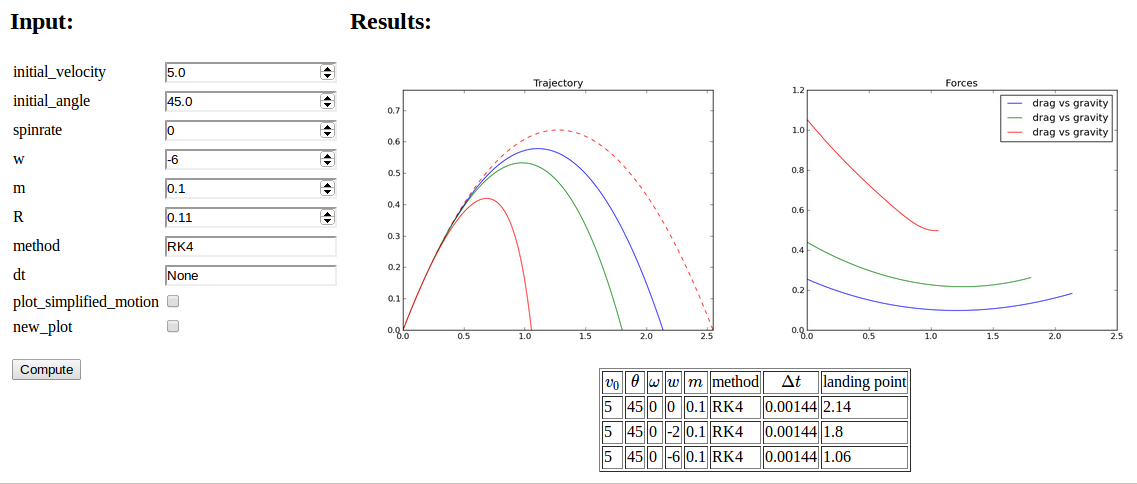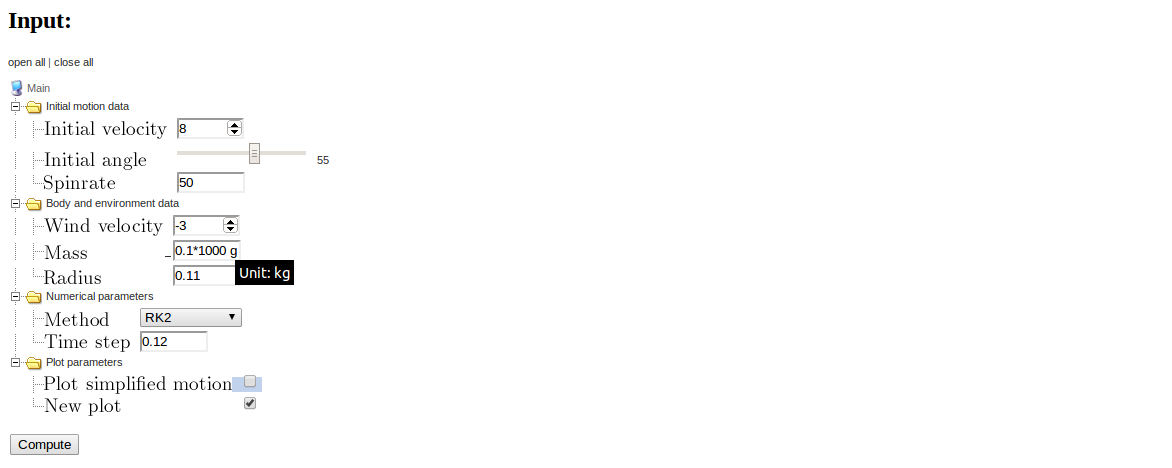The parampool package is a tool for administering a pool of parameters
in scientific applications. The package contains
- a general tree data structure in Python (subpackage
tree), - an application of the tree structure to pools of input parameters
for simulation programs (subpackage
pool), - tools for automatic generation of web-based user interfaces
(subpackage
generator), based on a pool or just a function.
With parampool it is very easy to equip a scientific application with
various kinds of user interfaces: graphical via web, command line,
and file input.
Here is a Python function taking some arguments, calling up computations, and returning the results as HTML code to be displayed in a browser (e.g., two plots and a table of results):
def compute_motion_and_forces0(
initial_velocity=5.0,
initial_angle=45.0,
spinrate=50.0,
w=0.0,
m=0.1,
R=0.11,
method='RK4',
dt=None,
plot_simplified_motion=True,
new_plot=True
):
Here is the Python code you need to write in order to generate a graphical user interface in a web browser:
from parampool.generator.flask import generate
from compute import compute_motion_and_forces
generate(compute_motion_and_forces, MathJax=True)
The result is a Flask application.
Running python controller.py and opening a web browser provide access
to the user interface. You can fill in values, press Compute, and
get results back.
Replace flask by django and you get a Django-based user interface
instead (!).
The user interface above was based on inspecting a Python function and its keyword arguments and default values. To get more control of the user interface, you can specify all the input parameters as a hierarichal tree, called pool tree. Here is an example:
- Main pool
-
Initial motion data
- Initial velocity:
initial_velocity - Initial angle:
initial_angle - Spinrate:
spinrate
- Initial velocity:
-
Body and environment data
- Wind velocity:
w - Mass:
m - Radius:
R
- Wind velocity:
-
Numerical parameters
- Method:
method - Time step:
dt
- Method:
-
Plot parameters
- Plot simplified motion:
plot_simplified_motion - New plot:
new_plot
- Plot simplified motion:
-
In Python, this may take the form
def pool_definition_list():
"""Create and return pool defined through a nested list."""
pool = [
'Main', [
'Initial motion data', [
dict(name='Initial velocity', default=5.0),
dict(name='Initial angle', default=45,
widget='range', minmax=[0,90], range_step=1),
dict(name=r'Spinrate', default=50, widget='float',
unit='1/s'),
],
'Body and environment data', [
dict(name='Wind velocity', default=0.0,
help='Wind velocity in positive x direction.',
minmax=[-50, 50], number_step=0.5,
widget='float', str2type=float),
dict(name='Mass', default=0.1, unit='kg',
validate=lambda data_item, value: value > 0,
help='Mass of body.'),
dict(name='Radius', default=0.11, unit='m',
help='Radius of spherical body.'),
],
'Numerical parameters', [
dict(name='Method', default='RK4',
widget='select',
options=['RK4', 'RK2', 'ForwardEuler'],
help='Numerical solution method.'),
dict(name='Time step', default=None,
widget='textline', unit='s'),
],
'Plot parameters', [
dict(name='Plot simplified motion', default=True,
help='Plot motion without drag+lift forces.'),
dict(name='New plot', default=True,
help='Erase all old curves.'),
],
],
]
from parampool.pool.UI import listtree2Pool
pool = listtree2Pool(pool)
return pool
There is more to learn when specifying a pool of parameters (compared to just providing a compute function), but you also get a lot fancier web-based graphical user interface or command-line (or file) interface. The interfaces are automatically generated with very few lines of code.
You can freely choose between a Flask or Django application for realizing the user interface.
Read the tutorial to learn how to use Parampool!

